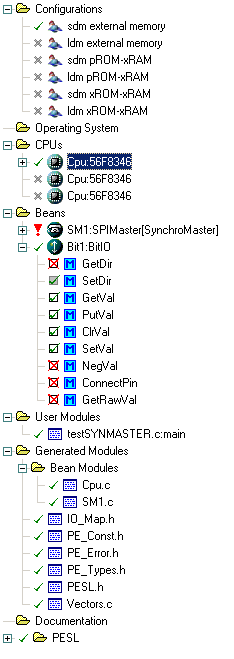Project Panel
Processor Expert | View | Project Panel Processor Expert Project Panel is a tab in CodeWarrior's project window
(panel). When the 'Project Panel' is noticed in Processor Expert documentation
the 'Processor Expert Project Panel' is understood.
The Project panel shows the application components:
All bean's items has its status icon that signalizes the enabled ( All Project Panel items are organized in folders in a tree. You can expand
and collapse a tree's branches by clicking on the plus "+" or
minus "-" signs, respectively. You can create your own folders
in the Beans folder and move beans between them using mouse
drag and drop function. The following icons indicate the status of each
project panel item: Beans - Processor Expert didn't found any problems in the
bean's settings. Configurations - configuration is selected as active. CPUs - CPU is currently selected as a target CPU. User Module, Generated Module - The module is all right and
included in the project. PESL - Processor Expert System Library is enabled. Beans - Gray cross means that bean is disabled and code won't
be generated for it. Configurations - Configuration is not active. Double click the
CPUs - CPU is not selected as target CPU. Double click the User Module - The user module is disabled. It is not possible
to disable the Main and Event modules. PESL - Processor Expert System Library is disabled. Icons The Project panel window allows quick access to supported methods
and events using mouse. See paragraph Other
mouse actions. Project panel pop-up menu is accessible by right click on the empty (white)
area of the Project Panel. Contains basic operations related to the project and
beans.
Pop-up menus of individual objects in project panel are accessible with a
right mouse button click on the object's icon or label.
Multiselect
Double click
Automatic Hints

Figure 1 - Processor Expert tab
![]() )
or disabled (
)
or disabled (![]() )
state. If this state cannot be directly changed, the background of the icon
is gray. For more details please see chapter Embedded
Beans.
)
state. If this state cannot be directly changed, the background of the icon
is gray. For more details please see chapter Embedded
Beans.
![]()
![]()
![]() icon to
select it as active configuration.
icon to
select it as active configuration.![]() icon to select it as the Target CPU.
icon to select it as the Target CPU.
![]()
Beans, CPUs - beans (CPU bean's)
settings are wrong or conflict with another bean. See chapter Bean
Checking for details.
![]()
Possibly incorrect setup was found in project or in bean's
settings. The warnings are displayed in Error window including simple
description.
![]()
![]()
![]()
![]() near the bean's icon mean the bean is individually setup for preserving user
changes in generated code. See chapter User
Changes in Generated Code for details.
near the bean's icon mean the bean is individually setup for preserving user
changes in generated code. See chapter User
Changes in Generated Code for details.Pop-up menu
All items from the imported file will be added into the current project.
Pop-up Menus of Objects
Other mouse actions

Figure 2 - The content of the
Project Panel